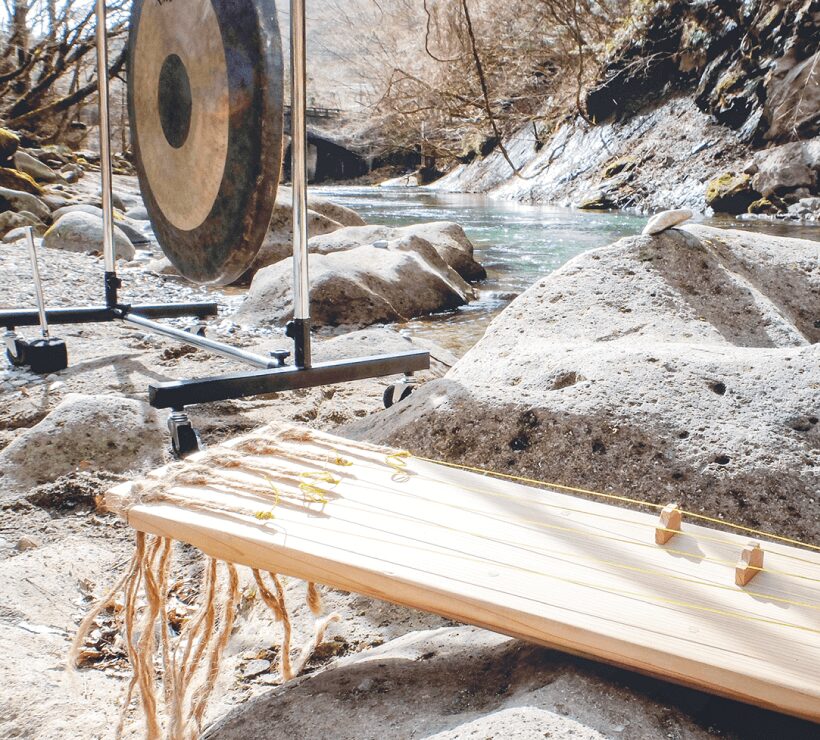
In the previous chapter (Gagakutan 12: The Living Essence of the Shō), we explored how the essence of "life" can be found in the form, tone, and performance of the shō. Let us delve further into this intriguing instrument.
◆Breathing In and Out: The Sound of Life

The shō is uniquely designed to produce the same sound whether you exhale or inhale—a rare feature in wind instruments worldwide.
Each of its bamboo pipes contains a reed. These reeds are meticulously crafted with precise cuts of fractions of a millimeter to allow vibrations that produce the same pitch regardless of airflow direction. This intricate design, combined with the pipes' varying lengths, creates the shō’s ethereal and mysterious sound.
This duality of “exhaling” and “inhaling” mirrors the essential life activity of breathing, shared by humans and countless other living beings.
Some have described the shō as an instrument with a “human-like quality,” as it reflects and embodies the rhythm of life itself.
Imagine if breath had sound or color. Reflecting on this, I felt an overwhelming sense of wonder for the act of breathing—a reminder of its fundamental importance. Perhaps the shō was born from an ancient vision of imbuing one’s breath with tone and color. Alternatively, people may have sought a connection to the heavens, intertwining their own breath—their essence of life—with the celestial sound of the shō.
Interestingly, Buddhist teachings emphasize the importance of mindful breathing, underscoring the spiritual significance of this act.
◆Harmony

The shō is also known for its ability to produce harmonies by playing five or six notes simultaneously, a technique called aitake. This makes it one of the few Japanese instruments capable of creating chords.
In gagaku, the shō contributes harmony to kangen (orchestral gagaku) and left-side bugaku (dance), while in genres like saibara and rōei, it can also perform melodic passages known as itchiku (single pipe playing). The individual notes of itchiku feel pure and enchanting, evoking an image of light stretching straight toward the heavens.
The shō integrates individual breaths and sounds to create harmony, symbolizing unity within the larger ensemble of gagaku.
This harmony—wa—represents more than just musical blending; it also embodies the harmony between humans and nature.
◆Harmony Between Humans and Nature

The shō is crafted entirely from natural materials:
Even the adhesives and repair materials were historically derived from natural sources. This reflects a deep connection between humans and the natural world.
The shō originated over 2,000–3,000 years ago in continental Asia, evolving in ancient China and Korea before arriving in Japan during the Asuka period around 1,400 years ago.
The philosophical concept of tian ren he yi(tenjingouitsu) (“the unity of heaven and humanity”), which emphasizes harmony between humans and nature, is deeply intertwined with the shō’s history. This idea, rooted in ancient Chinese thought, holds that humanity and nature are interconnected, and their balance represents the highest ideal. This philosophy permeated Japanese thought, influencing areas such as medicine, music, and spirituality.
Through its sound, the shō fosters harmony in gagaku performances, connects musicians to their instruments, and bridges the gap between humanity and nature.
The shō embodies both life and harmony.
Perhaps this unity of life and harmony is the ultimate ideal—a symbiotic relationship where each enhances the other.

◆Closing Thoughts
There remains much to be uncovered about the shō as a symbol of life and harmony.
For now, however, we conclude here. Recently, Mr.Tarō and I had the privilege of meeting a master who has dedicated over half a century to exploring the shō. We look forward to sharing his insights with you soon.
Written by Atsuko Aoyagi / ao.Inc.
#dailythoughts #japanesetraditionalmusic #composition
#gagaku #composinggagaku #nonmusic #gagakuperformance
#filmmusic #cinematicmusic #spatialmusic #gagakustories #sidenotes
#layer #mysterious #shogun #taroishida
